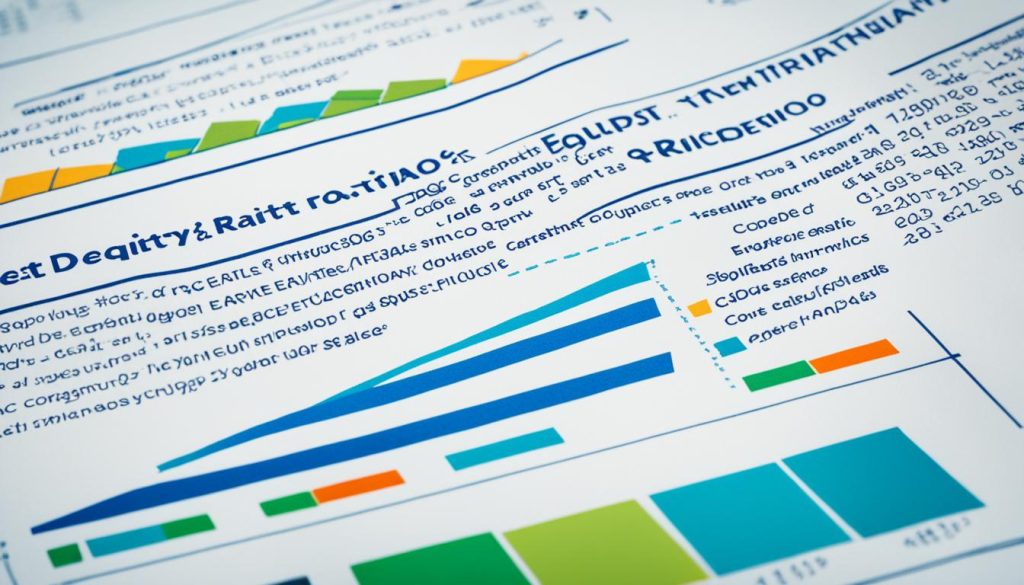The gearing ratio is a fundamental financial metric that plays a crucial role in assessing a company’s financial health and stability. It measures the proportion of a company’s capital that is financed by debt compared to equity. In simpler terms, it indicates how much of a company’s operations are funded by debt.
In this comprehensive guide, we will delve into the intricacies of the gearing ratio, exploring its significance, calculation methods, and implications for businesses. Whether you’re a seasoned financial professional or new to the world of finance, understanding the gearing ratio is essential for making informed business decisions and evaluating investment opportunities.
Join us as we unravel the mysteries of the gearing ratio and discover how this key financial metric can provide valuable insights into a company’s financial structure and performance.
What is a Gearing Ratio?
Gearing ratios are a group of financial metrics that assess a company’s amount of leverage and financial stability. They provide insight into how much of a company’s operations are funded by debt versus equity. Gearing ratios play a crucial role for both internal and external parties involved in a company’s financial health.
Financial institutions heavily rely on gearing ratios when making loan decisions. By analyzing a company’s gearing ratio, lenders can assess the level of risk associated with providing funds. This ratio helps them determine whether a company has the capacity to take on additional debt or if it is already heavily leveraged.
Internal management also utilizes gearing ratios to analyze cash flows and leverage. By understanding the proportion of debt and equity financing, managers can make informed decisions regarding capital allocation and investment strategies.
Gearing ratios are particularly valuable when compared to ratios of other companies within the same industry. Such comparisons allow for a benchmark assessment of a company’s performance and financial standing. It helps identify whether a company has a healthy level of leverage compared to industry averages and competitors.
To illustrate the importance of understanding gearing ratios, let’s consider an example:
| Company | Gearing Ratio |
|---|---|
| Company A | 50% |
| Company B | 30% |
| Company C | 70% |
In this example, Company A has a higher gearing ratio compared to Company B, indicating a higher level of financial leverage. Company C, on the other hand, has an even higher gearing ratio, suggesting a potentially riskier financial position.
By analyzing and interpreting gearing ratios, stakeholders can effectively evaluate a company’s financial stability, identify potential risks, and make informed decisions regarding investments or partnerships.

Why Gearing Ratios Matter?
Gearing ratios provide a comprehensive view of a company’s leverage, financial risk, and stability. They help investors, lenders, and managers gauge a company’s financial health and make informed decisions. By analyzing gearing ratios, stakeholders can:
- Assess the level of risk associated with providing loans or investing in a company
- Compare a company’s performance to industry averages and competitors
- Identify potential financial vulnerabilities and risks
- Mitigate potential financial distress by adjusting capital structure and debt levels
- Analyze cash flows and leverage to optimize investment strategies
Overall, gearing ratios serve as a critical tool in financial analysis and decision-making, providing valuable insights into a company’s financial position and helping stakeholders navigate the complexities of the business landscape.
Components of the Gearing Ratio Calculation
The gearing ratio is a key financial metric. It shows a company’s capital structure and financial stability. To work out the gearing ratio, you need to know about debt and equity. These are the main parts of the gearing ratio formula. This formula helps understand a business’s financial health and how it handles its debts.
Debt includes short-term and long-term loans, overdrafts, and other financing deals. It’s the money the company owes to banks, bondholders, or other lenders. Equity, however, is the money shareholders put into the company. This includes paid-up capital, profits kept back, and other reserves.
Some gearing ratios also look at total assets or total liabilities. Adding these gives a fuller picture of the company’s finances. It shows how well the company can meet its financial duties.
| Component | Description |
|---|---|
| Debt | Short-term debt, long-term debt, bank overdrafts, and other financing agreements |
| Equity | Paid-up capital, retained earnings, and other reserves |
| Total Assets | The overall value of a company’s assets, including both current and non-current assets |
| Total Liabilities | The total amount of a company’s debts and other financial obligations |
Knowing what makes up the gearing ratio helps businesses understand their finances better. They can make smart choices to improve their capital mix. This can lead to better financial performance overall.
Types of Gearing Ratios and How to Calculate them?
When it comes to assessing a company’s leverage, there are several types of gearing ratios that can be calculated. Each ratio provides valuable insights into different aspects of the company’s financial structure. Some of the key gearing ratios include:
1. Debt-to-Equity Ratio:
The debt-to-equity ratio compares a company’s total debt to its total equity. It indicates the proportion of funds provided by creditors compared to shareholders. The formula for calculating the debt-to-equity ratio is:
Debt-to-Equity Ratio = Total Debt / Total Equity
2. Times Interest Earned Ratio:
The times interest earned ratio measures a company’s ability to cover its interest expenses with its earnings. It reveals how well a company can meet its interest payment obligations. The formula for calculating the times interest earned ratio is:
Times Interest Earned Ratio = Earnings Before Interest and Taxes (EBIT) / Interest Expenses
3. Equity Ratio:
The equity ratio provides insights into the proportion of a company’s assets funded by shareholders’ equity. It indicates the company’s reliance on equity financing rather than debt financing. The formula for calculating the equity ratio is:
Equity Ratio = Shareholders’ Equity / Total Assets
4. Debt Ratio:
The debt ratio assesses the percentage of a company’s assets funded by debt. It shows the company’s level of financial risk and its ability to repay its debts. The formula for calculating the debt ratio is:
Debt Ratio = Total Debt / Total Assets
To calculate these gearing ratios, you will need to gather the necessary financial information from the company’s earnings report. This includes the total debt, total equity, total assets, earnings before interest and taxes (EBIT), and interest expenses. Once you have the data, apply the appropriate formula to obtain the gearing ratio.
Understanding and analyzing these different gearing ratios can provide valuable insights into a company’s financial structure, leverage, and risk. By comparing the calculated ratios to industry benchmarks, investors and analysts can assess a company’s performance and make informed decisions.

| Gearing Ratio | Calculation | Result |
|---|---|---|
| Debt-to-Equity Ratio | Total Debt / Total Equity | 1.5 |
| Times Interest Earned Ratio | EBIT / Interest Expenses | 4.2 |
| Equity Ratio | Shareholders’ Equity / Total Assets | 0.6 |
| Debt Ratio | Total Debt / Total Assets | 0.4 |
Interpreting and Evaluating Gearing Ratios
The interpretation of gearing ratios plays a crucial role in understanding a company’s financial position and risk. By analyzing these ratios, investors and stakeholders can gain valuable insights into a company’s leverage and its ability to handle financial obligations.
A gearing ratio measures the proportion of a company’s operations funded by debt relative to equity. Generally, a higher gearing ratio indicates a greater reliance on debt, which can lead to higher financial risk. However, it is important to note that a high gearing ratio does not necessarily signify poor financial condition. In certain industries or situations, higher leverage may be justifiable and considered normal.
To accurately evaluate a company’s gearing ratio, it is essential to compare it with other companies within the same industry. This comparison allows for a benchmark analysis and provides a better understanding of the company’s performance in relation to its peers.
Here are a few examples of how gearing ratios can be used to assess a company:
- Benchmarking against industry averages: By comparing a company’s gearing ratio with the average ratio for its industry, investors can evaluate its financial stability and determine how it fares against its competitors.
- Comparing against competitors’ ratios: Analyzing the gearing ratios of direct competitors allows investors to identify key differences and gain insights into each company’s financial strategy and risk management practices.
Example Gearing Ratio Table:
| Company | Gearing Ratio | Industry Average |
|---|---|---|
| Company A | 0.65 | 0.55 |
| Company B | 0.40 | 0.50 |
| Company C | 0.75 | 0.60 |
This table demonstrates how three companies compare to the industry average in terms of gearing ratio. It allows investors to identify outliers and further investigate the reasons behind their ratios. For instance, Company C has a higher gearing ratio than its peers, indicating a higher degree of leverage. Investors may want to assess whether Company C’s strategy aligns with industry norms and evaluate its risk management measures.
It is worth noting that interpreting gearing ratios should be done with caution, as the optimal ratio can vary depending on factors such as industry, economic conditions, and the company’s growth strategy. Therefore, it is recommended to analyze gearing ratios alongside other financial metrics to gain a comprehensive understanding of a company’s financial health.

Gearing Ratio vs. Other Debt Ratios
The gearing ratio is a key metric in financial analysis, but it’s not the only one. It helps us see how a company uses debt and its risk level. By comparing different debt ratios, we get a fuller picture of a company’s financial health.
Other debt ratios like the debt ratio, equity ratio, and times interest earned ratio are also important. The debt ratio shows how much debt a company has compared to its assets. The equity ratio looks at how much equity a company has compared to its assets. This tells us how much debt versus equity is used for financing.
The times interest earned ratio is vital too. It compares a company’s earnings before interest and taxes (EBIT) to its interest expenses. A higher ratio means the company can easily cover its interest payments, showing it’s in a good position financially.
| Ratio | Formula | Interpretation |
|---|---|---|
| Gearing Ratio | Total Debt / Total Equity | Measures the extent of a company’s reliance on debt financing compared to equity financing. |
| Debt Ratio | Total Debt / Total Assets | Indicates the proportion of a company’s assets that are financed by debt. |
| Equity Ratio | Total Equity / Total Assets | Reveals the extent to which a company’s assets are financed by equity rather than debt. |
| Times Interest Earned Ratio | EBIT / Interest Expense | Measures a company’s ability to meet its interest payments, with a higher ratio indicating a stronger capacity to service debt. |
Looking at these debt ratios together with the gearing ratio gives a clearer view of a company’s finances. It helps in making better strategic decisions and improving financial analysis.
Limitations of the Gearing Ratio
The gearing ratio is a key financial tool, but it has its limits. It can’t fully capture the differences between industries. For example, companies in utilities or asset-heavy sectors often have higher gearing ratios. This is because of their business models and the type of assets they have.
Also, the gearing ratio doesn’t consider the rules a company follows. These rules can change a lot by industry. They affect how much debt a company can have, which in turn affects its gearing ratio.
Moreover, the gearing ratio is a snapshot and might not show a company’s true financial health. It doesn’t look at how well a company can handle its debts or its cash flow. These are important things the gearing ratio doesn’t tell us.
Industry Differences and Regulatory Considerations
When comparing companies across different sectors, the gearing ratio’s limits are clear. Companies in sectors needing lots of assets, like manufacturing or real estate, often have higher gearing ratios. This is because they need more capital.
Rules from regulators also play a big part in what debt levels are okay for companies. For example, banking or utilities have stricter rules. These rules set limits on how much debt is allowed.
The Need for a Holistic Approach
To really understand a company’s financial health, we need to look at more than just the gearing ratio. We should consider other financial metrics and qualitative factors too. Looking at industry trends, regulatory rules, and a company’s financial strength gives a clearer picture of its debt management and future stability.
Strategies for Optimising Gearing Ratio
Keeping a healthy gearing ratio is key for businesses to balance debt and equity financing well. Companies can use different strategies to make their gearing ratio better. These strategies focus on managing debt, profits, and expenses.
Debt management is a main strategy. It means paying off loans, getting better interest rates, or avoiding new debt. By doing this, companies can make their financial health better.
Profit management is also important. Making more money and being more profitable can increase the equity part of the gearing ratio. This could mean cutting costs, finding new customers, or exploring new markets.
Expense management is vital too. By keeping an eye on and reducing costs, companies can lessen their debts and improve their finances. This might mean making processes more efficient, talking to suppliers, or finding ways to save money throughout the company.
Using these strategies together helps companies manage their gearing ratio well. It improves how they handle debt, profits, and expenses. This makes their financial health and resilience stronger.
Conclusion
Gearing ratios are crucial financial metrics that provide insights into the proportion of a company’s operations funded by debt versus equity. They play a vital role in assessing a company’s leverage and financial risk. To accurately interpret gearing ratios, it is important to consider the industry and context, and compare them to industry averages and competitors’ ratios.
A good gearing ratio varies depending on the industry, but a generally accepted range is between 25% and 50%. However, it is essential to note that what constitutes a good gearing ratio can vary based on the company’s specific circumstances and goals. Companies should aim to maintain a gearing ratio that aligns with industry standards while considering their growth strategies and risk tolerance.
To improve their gearing ratio, businesses can take several measures. First, managing debt levels effectively is crucial. This can involve refinancing existing debt, negotiating better repayment terms, or strategically balancing different types of debt. Second, boosting profits can positively impact the gearing ratio by increasing shareholders’ equity. Strategies may include cost optimization, revenue growth initiatives, and improved operational efficiency. Finally, reinvesting in the business can also enhance the gearing ratio by increasing retained earnings and equity.
By maintaining a healthy gearing ratio, businesses can enjoy the benefits of financial stability, better access to funding, and improved investment opportunities. Regular monitoring and periodic adjustments to the gearing ratio can help companies stay on track and achieve their financial objectives.
FAQs
What are some types of gearing ratios and how do you calculate them?
Some types of gearing ratios include the debt-to-equity ratio, times interest earned ratio, equity ratio, and debt ratio. The formulas for these ratios vary, but they all involve comparing debt to equity or other metrics. To calculate a gearing ratio, you need to gather the necessary financial information from the company’s earnings report, such as total debt, total equity, and total assets. Then, use the appropriate formula to calculate the ratio.
How do you interpret and evaluate gearing ratios?
The interpretation of gearing ratios depends on the context and industry. Generally, a higher gearing ratio indicates a higher degree of leverage and financial risk. However, a high gearing ratio does not always indicate poor financial condition, as there may be valid reasons for higher leverage in certain industries or situations. It is important to compare a company’s gearing ratio to those of other companies in the same industry to assess its performance.
What is a good gearing ratio for a business?
A good gearing ratio varies by industry, but a generally accepted range is between 25% and 50%. Companies can improve their gearing ratio by managing their debt levels, boosting profits, and reinvesting in the company.
Is a 75% gearing ratio good?
A gearing ratio of 75% indicates that a company is using a significant amount of debt to finance its operations. Whether a 75% gearing ratio is good or not depends on various factors such as industry standards, company stability, and risk tolerance. It’s essential to assess the specific context before determining if this ratio is favorable.
What is a comfortable gearing ratio?
The concept of a comfortable gearing ratio varies among industries and companies. A comfortable gearing ratio is typically one that allows a company to meet its financial obligations without being overly burdened by debt. It should strike a balance between leveraging debt for growth and maintaining financial stability.
How to read gearing ratio?
To read a gearing ratio, you need to understand what it represents – the proportion of a company’s debt to its equity. A gearing ratio above 50% usually indicates higher reliance on debt financing. It’s important to analyze the trend of the gearing ratio over time and compare it to industry benchmarks for a meaningful interpretation.





